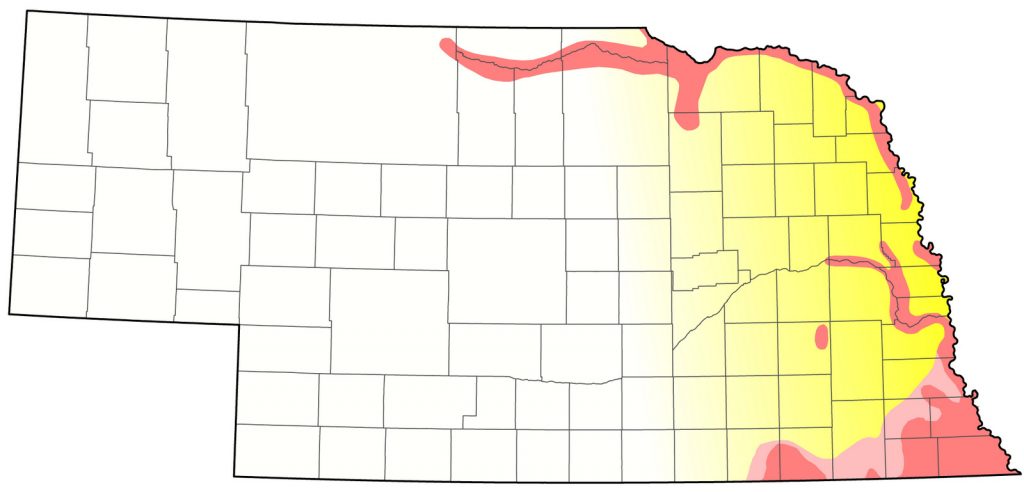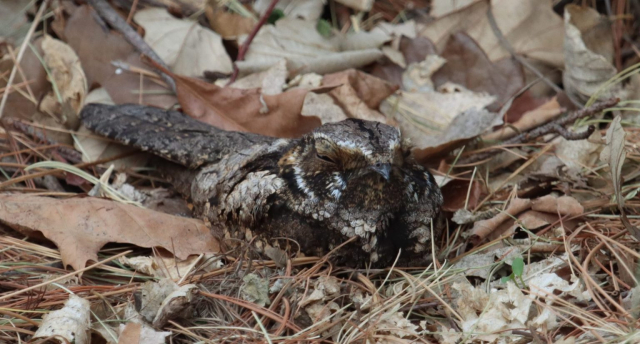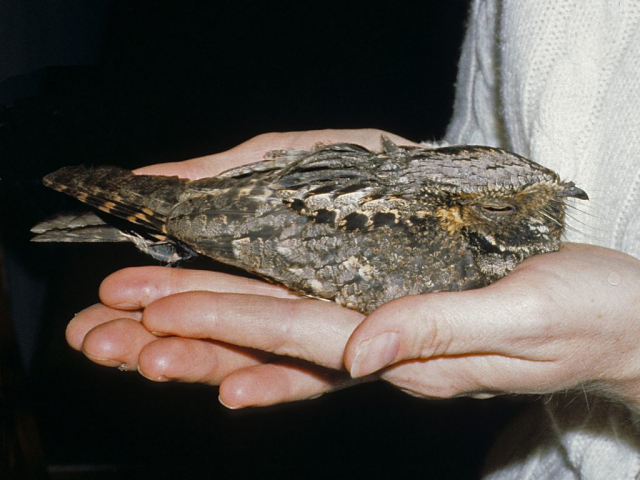Antrostomus vociferus
Status: Common regular breeder and spring and fall migrant east, rare central.

Documentation: Specimen: HMM 2733, 2 May 1896 Giltner, Hamilton Co.
Taxonomy: No subspecies are recognized (AviList 2025).
This species and 10 others previously in Caprimulgus were moved to Antrostomus (AviList 2025) based on Han et al (2010).
Spring: Apr 17, 18, 18 <<<>>> summer
Arrival is in late Apr. An earlier date is of one that hit a window 13 Apr 2018, recovered, and was released after photographs were taken (Elaine Bachel, personal communication).
Arrival is in late Apr. The only reports from the western half of the state, none with tangible evidence, are of one in Perkins Co 6 May 1970 identified by size and wing length relative to the tail (Cortelyou 1970), one in Dawson Co 28 Apr 1935, the only local record (Kinch 1964), one in McPherson Co 17 Jun 1972 (Cortelyou 1972), and one heard at Keystone, Keith Co 16 May 2021 by an observer familiar with calls of this species and Mexican Whip-poor-will.
One was westerly near Gibbon, Buffalo Co 22 May 2001, and one was in Hall Co 19 May 2021. Whip-poor-will was considered a rare migrant in Hamilton Co in 1962 (Swanson 1962). A bird reported as this species with “pretty definite white on the sides of its tail” was flushed at Sacramento-Wilcox WMA, Phelps Co 20 Apr 2020 by an observer familiar with Common Poorwill (Bob Meduna, pers. comm.); this is a westerly location for this species and the possibility of Common Poorwill, although easterly at the location but probably more likely, could not be eliminated from the description. Whip-poor-will is a casual migrant in eastern Colorado in May and Sep (Andrews and Righter 1992; eBird.org, accessed May 2021).
- High counts: 17 at Oak Glen WMA, Seward Co 26 May 2010, 14 at Indian Cave SP, Nemaha and Richardson Cos 12 May 2001, 14 at Oak Glen WMA 11 May 2017, and 14 there 30 May 2018.
Summer: Like Chuck-will’s-widow, documented nesting records are few, perhaps six in all. Most recent are of a nest with two eggs at Ponca SP, Dixon Co 16 May 2009 (Mollhoff 2016) and a nest with an egg and a chick photographed at Indian Cave SP, Richardson Co 3 Jul 2014.
Breeding or territorial birds occur in oak-hickory forest in the southeast, along the lower Platte River Valley, and along the lower Niobrara River Valley (Brenner and Jorgensen 2019, 2020). The species is often absent in woodland habitat that is intensively grazed (Youngworth 1958), and in dense, closed-canopy forest, preferring relatively open woodland habitats (Cink et al 2020).
In the Niobrara River Valley, westernmost record is of one at Anderson Bridge WMA, Cherry Co 6 Jun 2023. It occurs regularly west to extreme eastern Cherry Co, where singing males were reported 3 and 14 Jun 1982 (Brogie and Mossman 1983); One was heard near Fort Niobrara NWR 2 Jun 2022 and another at nearby Borman Bridge WMA 23 May 2023. There are multiple reports from Smith Falls SP, Cherry Co, and reports of one calling at Berry Bridge Campground, Cherry Co, 26 May 2017, and in 2020 calling birds at three locations along the river between Berry Falls and Smith Falls 21 Jun (Gordon Warrick, Jim Ducey, personal communication). One was heard along Highway 12 in extreme western Keya Paha Co 7 May 2002, two were in eastern Keya Paha Co 12 Jun 2014, and 1-4 were counted at each of eight stops along Ponca Creek on Highway 12 in Boyd Co 28 Jun 2012. A 2019 survey found good numbers in the three-county Middle Niobrara Valley Biologically Unique Landscape, with best count per survey route the nine in Keya Paha Co (Brenner and Jorgensen 2019).
Although nesting is undocumented at NNF Bessey, Thomas Co, there have been recent reports during the nesting season suggestive of nesting; these are 9 May 2009, 26 Jun 2015, 28 Jun 2011, 27 Jun 2013, and 3 Jul 2015. Bruner et al (1904) listed this species as occurring rarely in Thomas Co, but without dates; these may have been migrants.
One at Yellowbanks WMA, Madison Co 7 Jul 2021 was at a new location in the Elkhorn River Valley.
It occurs regularly in the Platte River Valley only west to the Morse Bluff area of northern Saunders Co, where 14 were counted 17-21 May 1995 (Silcock 1995); However, there are several records from Oak Glen WMA, Seward Co, on Oak Creek, a tributary of Salt Creek and ultimately the Platte River; it was first reported there 25 Jun 1995 and a good tally of 16 was made there 15 Jul 2006. Whip-poor-wills were unreported in Hall Co by Lingle (1994), although Mollhoff (2001) showed a “possible” breeding record in Hall Co in the period 1984-89.
In the southeast, it occurs mostly in major river drainages such as the Big Nemaha, Big Blue, and Little Blue rivers. In the Big Nemaha drainage, it occurs in most of Pawnee Co, where it has been noted for some time (Bennett 1974, Johnsgard 1980). On the Big Blue River, there are only two reports: two at Beatrice, Gage Co 14 May 2020, and along 108 Road, Gage Co 6 May 2023. There are several reports from the Little Blue River Valley in Jefferson Co, including about 15 reports north of Fairbury; northwesternmost in this drainage was one at Alexandria Lakes RA on Big Sandy Creek 6 Jun 2023.
- Breeding Phenology:
Eggs: 15 May-3 Jul
Nestlings: 3 Jul
- High counts: 40+ at Thomas Creek WMA, Keya Paha Co 26 Jun 2016, 30 at Indian Cave SP 30 Jun 2010, and 14 in Sarpy Co 23 Jun 1996.
Fall: summer <<<>>> Sep 18, 18, 19
Later dates are 17-27 Sep 2020 Schramm SP, Sarpy Co, 30 Sep 2001 Ponca SP, Dixon Co, and 29 Sep-3 Oct 2021 Schramm SP.
Migration occurs in late Aug and Sep. “Scores” were heard at Platte River SP, Cass Co 3 Sep 1983 where none were heard 8 Aug; these birds were considered migrants (Green 1984). It appears that summer singing tails off by early Sep but there may be a resurgence just prior to fall departure in mid-late Sep. One was recorded at Ponca SP, Dixon Co 16 Sep 2018 and up to four were recorded at Schramm SP, Sarpy Co through 27 Sep 2020, and up to three were recorded 29 Sep-3 Oct 2021.
Roger Sharpe (personal communication) reported a period of regular fall singing (albeit weak and non-repetitive) in early to mid-Sep in eastern Nebraska and western Iowa; sporadic songs may be heard year-round (Cink et al 2020).
Whip-poor-wills may occur on occasion west of the summer range during fall migration; three were heard in Polk Co 2 Sep 2012, singles were seen at Wilderness Park, Lincoln, Lancaster Co 23 and 24 Sep 2000, and westernmost was one calling in Lincoln Co 8 Sep 2014. This species is a casual migrant in eastern Colorado in May and Sep (Andrews and Righter 1992).
Tracking studies by Skinner et al (2022) indicated that Whip-poor-wills breeding in the central United States (ie western half of the summer population) undergo a synchronized fall migration around the western end of the Gulf of Mexico, congregating in early October in an area from southern Missouri to northeastern Texas and wintering in southern Mexico and northern Central America.
Images
Abbreviations
HMM: Hastings Municipal Museum
NNF: Nebraska National Forest
SP: State Park
WMA: Wildlife Management Area (State)
UNSM: University of Nebraska State Museum
Literature Cited
Andrews, R., and R. Righter. 1992. Colorado birds. Denver Museum of Natural History, Denver, Colorado, USA.
AviList Core Team, 2025. AviList: The Global Avian Checklist, v2025. https://doi.org/10.2173/avilist.v2025.
Bennett, E.V. 1974. 1973 Nebraska nesting survey. NBR 42: 3-10.
Brenner, S.J., and J.G. Jorgensen. 2019. Distribution, abundance, and habitat associations of Chuck-will’swidow (Antrostomus carolinensis) and Eastern Whip-poor-will (Antrostomus vociferus) in eastern Nebraska. Nongame Bird Program of the Nebraska Game and Parks Commission, Lincoln,
Nebraska, USA.
Brenner, S.J., and J.G. Jorgensen. 2020. Range limits and habitat associations of Eastern Whip-poor will (Antrostomus vociferous) and Chuck-wills-widow (Antrostomus carolinensis) across eastern Nebraska. Nongame Bird Program of the Nebraska Game and Parks Commission, Lincoln, Nebraska, USA.
Brogie, M.A., and M.J. Mossman. 1983. Spring and summer birds of the Niobrara Valley Preserve, Nebraska: An annotated checklist. NBR 51: 44-51.
Bruner, L., R.H. Wolcott, and M.H. Swenk. 1904. A preliminary review of the birds of Nebraska, with synopses. Klopp and Bartlett, Omaha, Nebraska, USA.
Cink, C.L., P. Pyle, and M.A. Patten. 2020. Eastern Whip-poor-will (Antrostomus vociferus), version 1.0. In Birds of the World (P. G. Rodewald, Editor). Cornell Lab of Ornithology, Ithaca, NY, USA. https://doi.org/10.2173/bow.whip-p1.01.
Cortelyou, R.G. 1970. 1970 (Forty-fifth) Spring Migration and Occurrence Report. NBR 38: 74-87.
Cortelyou, R.G. 1972. 1972 (Forty-seventh) Spring Migration and Occurrence Report. NBR 40: 72-86.
Green, R.C. 1984. Whip-poor-wills. NBR 52: 24.
Han, L-K., M.B. Robbins, and M.J. Braun. 2010. A Multi-gene Estimate of Phylogeny in the Nightjars and Nighthawks (Caprimulgidae). Molecular Phylogenetic Evolution 55: 443-453.
Johnsgard, P. A. 1980. A preliminary list of the birds of Nebraska and adjacent Great Plains states. Published by the author, University of Nebraska, Lincoln, USA.
Kinch, C. 1964. Some Dawson County records. NBR 32: 37-40.
Lingle, G.R. 1994. Birding Crane River: Nebraska’s Platte. Harrier Publishing, Grand Island, Nebraska, USA.
Mollhoff, W.J. 2001. The Nebraska Breeding Bird Atlas 1984-1989. Nebraska Ornithologists’ Union Occasional Papers No. 7. Nebraska Game and Parks Commission, Lincoln, Nebraska, USA.
Mollhoff, W.J. 2016. The Second Nebraska Breeding Bird Atlas. Bull. Univ. Nebraska State Museum Vol 29. University of Nebraska State Museum, Lincoln, Nebraska, USA.
Silcock, W.R. 1995. Spring Field Report, March-May 1995. NBR 63: 34-60.
Skinner, A.A., M.P. Ward, I. Souza-Cole, J.R. Wright, F.R. Thompson III, T.J. Benson, S.N. Matthews, and C.M. Tonra. 2022. High spatiotemporal overlap in the non-breeding season despite geographically dispersed breeding locations in the eastern whip-poor-will (Antrostomus vociferus) Diversity and Distributions https://doi.org/10.1111/ddi.13477.
Swanson, K.S. 1962. Birding areas near Aurora. NBR 30: 18-20.
Youngworth, W. 1958. Dakota County spring notes. NBR 26: 68.
Recommended Citation
Silcock, W.R., and J.G. Jorgensen. 2025. Eastern Whip-poor-will (Antrostomus vociferus). In Birds of Nebraska — Online. www.BirdsofNebraska.org
Birds of Nebraska – Online
Updated 9 Jul 2025


